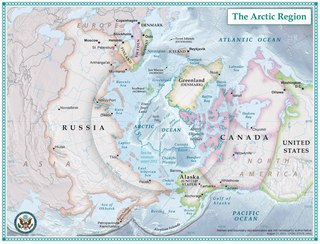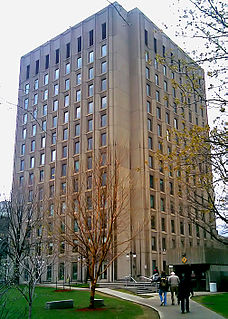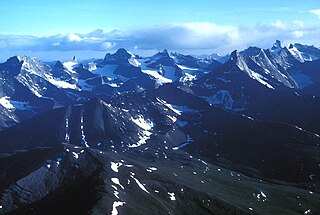
In physical geography, tundra is a type of biome where the tree growth is hindered by low temperatures and short growing seasons. The term tundra comes through Russian тундра from the Kildin Sami word тӯндар meaning "uplands", "treeless mountain tract". Tundra vegetation is composed of dwarf shrubs, sedges and grasses, mosses, and lichens. Scattered trees grow in some tundra regions. The ecotone between the tundra and the forest is known as the tree line or timberline.

The Arctic is a polar region located at the northernmost part of Earth. The Arctic consists of the Arctic Ocean, adjacent seas, and parts of Alaska, Finland, Greenland (Denmark), Iceland, Northern Canada, Norway, Russia and Sweden. Land within the Arctic region has seasonally varying snow and ice cover, with predominantly treeless permafrost -containing tundra. Arctic seas contain seasonal sea ice in many places.

The Arctic National Wildlife Refuge is a national wildlife refuge in northeastern Alaska, United States. It consists of 19,286,722 acres (78,050.59 km2) in the Alaska North Slope region. It is the largest national wildlife refuge in the country, slightly larger than the Yukon Delta National Wildlife Refuge. The refuge is administered from offices in Fairbanks. The Arctic National Wildlife Refuge is the biggest and the wildest land publicly owned by the United States. ANWR includes a large variety of species of plants and animals, such as polar bears, caribou, wolves, eagles, and migratory birds, that rely on the refuge.

Arctic Village is an unincorporated Native American village and a census-designated place (CDP) in Yukon-Koyukuk Census Area, Alaska, United States. As of the 2010 census, the population of the CDP was 152. This was unchanged from 2000. The village is located in the large Gwitch'in speaking region of Alaska, and the local dialect is known as Di'haii Gwitch'in or Kutchin. As of 1999, over 95% of the community speaks and understands the language.

The Continental Divide is the principal, and largely mountainous, hydrological divide of the Americas. The Continental Divide extends from the Bering Strait to the Strait of Magellan, and separates the watersheds that drain into the Pacific Ocean from those river systems that drain into the Atlantic Ocean and, along the northernmost reaches of the Divide, those river systems that drain into the Arctic Ocean.

The Iñupiat are native Alaskan people, whose traditional territory spans Norton Sound on the Bering Sea to the Canada–United States border. Their current communities include seven Alaskan villages in the North Slope Borough, affiliated with the Arctic Slope Regional Corporation; eleven villages in Northwest Arctic Borough; and sixteen villages affiliated with the Bering Straits Regional Corporation.

The Brooks Range is a mountain range in far northern North America stretching some 700 miles (1,100 km) from west to east across northern Alaska into Canada's Yukon Territory. Reaching a peak elevation of 8,976 feet (2,736 m) on Mount Isto, the range is believed to be approximately 126 million years old.

Gates of the Arctic National Park and Preserve is an American national park that protects portions of the Brooks Range in northern Alaska. The park is the northernmost national park in the United States, situated entirely north of the Arctic Circle. The park is the second largest in the US at 8,472,506 acres, slightly larger in area than Belgium. Gates of the Arctic was initially designated as a national monument on December 1, 1978, before being redesignated as a national park and preserve upon passage of the Alaska National Interest Lands Conservation Act in 1980. A large part of the park has additional protection as the Gates of the Arctic Wilderness which covers 7,167,192 acres (2,900,460 ha). The wilderness area adjoins the Noatak Wilderness and together they form the largest contiguous wilderness in the United States.

Bathurst Island is one of the Queen Elizabeth Islands in Nunavut, Canada. It is a member of the Canadian Arctic Archipelago. The area of the island is estimated at 16,042 km2 (6,194 sq mi), 115 to 117 mi long and from 63 mi (101 km) to 72 mi (116 km) to 92.9 mi (149.5 km) wide, making it the 54th largest island in the world and Canada's 13th largest island. It is uninhabited.

Gates of the Arctic Wilderness is a wilderness area in the U.S. state of Alaska. Located in the Gates of the Arctic National Park and Preserve, it is 7,245,600-acre (2,932,200 ha) in area, the third-largest designated wilderness area in the United States.

Lieutenant Colonel Eric Stewart Marshall was a British Antarctic explorer with the Nimrod Expedition led by Ernest Shackleton in 1907–09, and was one of the party of four men who reached Furthest South at 88°23′S162°00′E on 9 January 1909.
Zoltán Szalkai is a Hungarian documentary film director. He studied agriculture and geology before turning to a career in directing documentary films.

The Department of Atmospheric and Oceanic Sciences of McGill University is the largest university atmospheric-oceanic sciences group in Canada. In 2012, it has 11 Faculty and 6 Associate Faculty members, 5 support staff, 14 research associates and postdoctoral fellows, and 31 graduate students. It is known worldwide, in particular for weather radar research and Arctic studies. It has operated the second oldest weather observatory in Canada since 1862.
Based on archeological finds, Brooman Point Village is an abandoned village in Qikiqtaaluk Region, Nunavut, Canada. It is located in the central High Arctic on a point of the Gregory Peninsula, part of the eastern coast of Bathurst Island. Brooman was both a Late Dorset culture Paleo-Eskimo village as well as an Early Thule culture village. Both the artifacts and the architecture, specifically longhouses, are considered important historical remains of the two cultures. The site shows traces of Palaeo-Eskimo occupations between about 2000 BC and 1 AD, but the major prehistoric settlement occurred from about 900 to 1200 AD.

The Arrigetch Peaks are a cluster of rugged granite spires in the Endicott Mountains of the central Brooks Range in northern Alaska. The name Arrigetch means 'fingers of the outstretched hand' in the Inupiat language. The peaks ring the glacial cirques at the head of the Kobuk River and 2 tributaries of the Alatna River: Arrigetch Creek and Aiyagomahala Creek. They are located at latitude 67 degrees 24' N and longitude 154 degrees 10' W. All of the summits of the peaks are around 6,000 ft, 1825 m elevation. The Arrigetch Peaks area was designated as a National Natural Landmark in 1968 for its spectacular geography.

Terminal Freeze is the fourth solo novel by Lincoln Child. The novel was released on February 24, 2009 by Random House. This is also the second novel in the Jeremy Logan series.

The North Fork of the Koyukuk River is one of the principal forks of the Koyukuk River, approximately 105 mi (160 km) long, in northern Alaska in the United States. It has a watershed area of 1,850 square miles (4,800 km2). It rises on the south slopes of the Continental Divide in the Brooks Range.

Wright Air Service is an American commuter airline based in Fairbanks, Alaska, United States. It was established by Al Wright and started operations in 1967. It is located off the east ramp near the Fairbanks International Airport. The president of the company was Robert Bursiel, but the company was recently bought out by a new owner in 2017.


















